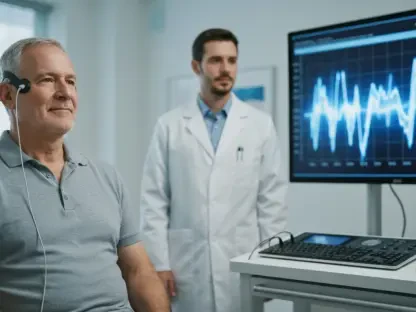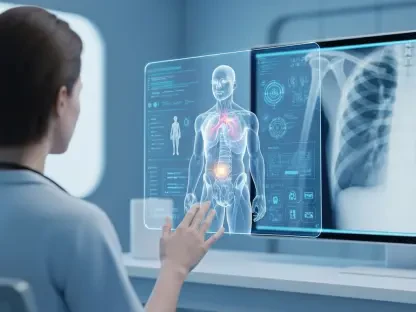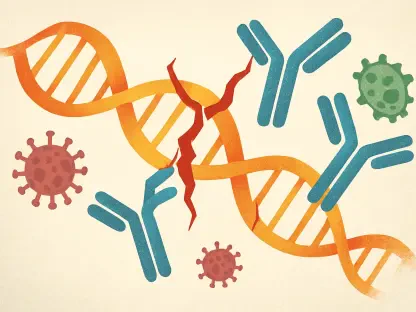In the realm of virology, understanding how viruses interact with host cells is paramount to developing effective treatments and preventive measures, particularly for respiratory pathogens like the influenza A virus, which poses significant public health challenges. Traditional two-dimensional (2D) cell cultures have long served as the backbone of viral research, offering a straightforward method to study virus replication and host responses. However, these models often fall short in replicating the complex physiological environments found in living organisms. Enter three-dimensional (3D) cell cultures, a promising alternative that aims to bridge the gap between in vitro studies and real-world conditions. By mimicking tissue architecture and cell-to-cell interactions more accurately, 3D models provide a closer approximation of how influenza A behaves in the human body. This shift in approach has sparked significant interest among researchers seeking more reliable data for antiviral drug development and vaccine production. Recent studies using cell lines like A549 and HEK293 have highlighted the potential of 3D spheroid cultures to transform the study of viral infections. This article delves into the comparative analysis of influenza A virus propagation in 2D and 3D cell culture systems, exploring their respective strengths, limitations, and implications for advancing medical research.
1. Evolution of Cell Culture Models in Virology
The journey of cell culture models in virology began with 2D monolayers, where cells are grown on flat surfaces like Petri dishes or multi-well plates. This method has been instrumental in uncovering fundamental aspects of viral replication and immune responses. A549 cells, derived from human alveolar epithelium, and HEK293 cells, originating from human embryonic kidney tissue, have been widely used in such setups to study influenza A virus. These 2D cultures allow for easy manipulation and observation, making them a cost-effective choice for high-throughput screening of antiviral compounds. However, their simplicity comes at a cost: they fail to capture the intricate spatial organization and nutrient gradients present in actual tissues. This limitation often results in data that may not fully translate to in vivo scenarios, prompting a reevaluation of how viral infections are studied in the lab.
The advent of 3D cell culture systems marks a significant leap forward in addressing the shortcomings of 2D models. These systems, including spheroids and organoids, create an environment where cells can interact in a manner akin to natural tissues. For influenza A research, 3D cultures of A549 and HEK293 cells have been developed using matrices like alginate (Alg) and a combination of alginate with methylcellulose (Alg+MC). Such setups better simulate the lung or kidney microenvironments, offering insights into virus-host dynamics that are more reflective of human physiology. Although 3D models are more complex and resource-intensive to establish, their ability to replicate tissue-like structures provides a valuable tool for understanding how influenza A propagates and interacts with host cells under conditions closer to reality.
2. Methodological Insights into 2D and 3D Cultures
Studying influenza A virus in 2D cultures typically involves growing A549 or HEK293 cells as monolayers and inoculating them with strains like #N1 (PR/8/34). The process is straightforward: cells are cultured in media such as Dulbecco’s Modified Eagle Medium (DMEM), supplemented with fetal bovine serum, and then exposed to the virus for a set period, often 24 to 48 hours. Viral propagation is assessed through techniques like quantitative PCR (qPCR) to measure gene expression or hemagglutination assays to determine viral titers. This approach benefits from simplicity and reproducibility, allowing researchers to rapidly test multiple conditions or antiviral agents. Yet, the flat, uniform nature of 2D cultures often overlooks critical factors like cell polarity and extracellular matrix interactions, which play significant roles in viral infection and spread within the body.
In contrast, 3D culture methodologies for influenza A studies involve creating spheroids of A549 and HEK293 cells embedded in hydrogel matrices such as Alg or Alg+MC. These spheroids are formed by suspending cells in the matrix and cross-linking them with calcium chloride to achieve a stable structure. After incubation, the spheroids are inoculated with the virus, and both internal and external supernatants are analyzed for viral load using qPCR. The structural complexity of 3D models allows for a more nuanced examination of how influenza A interacts with cells in a tissue-like context, including variations in viral access and diffusion. However, challenges such as inconsistent spheroid size and the labor-intensive nature of maintaining these cultures can complicate experimental outcomes, requiring careful optimization to ensure reliable results.
3. Comparative Viral Propagation Results
When comparing the propagation of influenza A virus in 2D and 3D cultures of A549 and HEK293 cells, distinct differences emerge in viral gene expression and replication efficiency. In 2D setups, both cell lines demonstrate consistent viral yields, with A549 cells often showing robust replication due to their respiratory origin. The controlled environment of 2D cultures facilitates uniform virus exposure, leading to predictable outcomes in terms of cytopathic effects and viral titers. Studies have indicated that after serial passages, influenza A adapts well to these cell lines, achieving significant hemagglutination titers. However, this consistency may mask the true variability of infection dynamics in a natural setting, where tissue architecture influences viral spread and host response in ways not captured by a monolayer system.
In 3D spheroid cultures, the results for influenza A propagation reveal a more complex picture. Using matrices like Alg and Alg+MC, researchers have observed that viral load varies depending on whether spheroids are dissolved or left intact during inoculation. For HEK293 cells, the Alg+MC matrix often shows less reduction in viral gene expression in external supernatants, suggesting better viral access due to higher porosity. In A549 cells, internal supernatants in both matrices exhibit notable viral presence, though overall reductions compared to 2D are statistically significant. These findings point to the influence of matrix composition on infection efficiency, with Alg+MC potentially enhancing cell-virus interactions. Despite these insights, 3D cultures do not always outperform 2D in viral yield, highlighting the need for further refinement to maximize their potential in virology research.
4. Advantages and Challenges of 3D Models
One of the standout advantages of 3D cell cultures in studying influenza A virus lies in their ability to emulate the physiological conditions of human tissues more accurately than 2D systems. Spheroids made from A549 and HEK293 cells, when embedded in matrices like Alg+MC, replicate the cellular architecture and nutrient gradients found in vivo, providing a clearer picture of how the virus behaves in a complex environment. This relevance is crucial for developing antiviral therapies and vaccines, as it allows for testing under conditions that mirror human responses more closely. Additionally, 3D models can reveal subtleties in viral propagation, such as differences in infection rates between internal and external cell layers, offering data that 2D cultures cannot provide due to their uniform structure.
However, the adoption of 3D cell cultures for influenza A research is not without significant challenges. The technical complexity of creating and maintaining spheroids, coupled with the high costs of materials and equipment, can pose barriers to widespread use. Variability in spheroid size and matrix consistency often leads to inconsistent experimental outcomes, requiring meticulous standardization. Moreover, while 3D models like Alg-based hydrogels are more affordable than alternatives such as Matrigel, they still lack certain extracellular matrix components essential for long-term culture stability. Issues like limited viral receptor expression in cell lines such as A549 and HEK293 can further hinder infection efficiency, suggesting that additional modifications, such as extended adaptation periods or matrix engineering, are necessary to fully realize the benefits of these advanced systems.
5. Matrix Composition and Its Impact on Viral Studies
The choice of matrix in 3D cell cultures plays a pivotal role in the study of influenza A virus, with materials like alginate (Alg) and its combination with methylcellulose (Alg+MC) offering distinct properties. Alg, derived from brown algae, forms a hydrogel with high water retention, facilitating nutrient and oxygen diffusion critical for cell viability. In experiments with A549 and HEK293 spheroids, Alg provides a stable scaffold for cell growth, though its relatively dense structure may limit viral penetration to internal cell layers. This matrix is valued for its biocompatibility and ease of handling, making it a practical choice for short-term viral propagation studies. However, its cohesive nature can sometimes restrict the dynamic interactions needed for optimal infection, prompting exploration of modified compositions to enhance performance.
Incorporating methylcellulose (MC) into alginate matrices creates a blend (Alg+MC) that significantly alters the structural dynamics for influenza A research. This combination increases porosity and reduces cohesion, allowing for easier dissolution during experimental procedures and potentially improving viral access to cells within spheroids. Studies have shown that Alg+MC supports higher viral replication in certain conditions, particularly with HEK293 cells, due to better diffusion properties. This matrix also enhances structural stability and viscosity, which can sustain spheroid integrity over extended culture periods. Despite these advantages, challenges remain in re-solidifying the matrix after dissolution, and its impact on viral yield varies across cell types and experimental setups, underscoring the importance of tailoring matrix selection to specific research goals.
6. Future Directions for Enhanced Viral Research
Looking ahead, the potential of 3D cell cultures to revolutionize influenza A virus research hinges on addressing current limitations through innovative strategies. One promising avenue involves optimizing matrix compositions by integrating extracellular matrix components or synthetic hydrogels to better mimic in vivo conditions. For cell lines like A549 and HEK293, functionalizing matrices with ligands that enhance viral receptor expression could improve infection rates. Additionally, extending virus-cell contact time during inoculation may boost replication efficiency, particularly in denser matrices like Alg. Such advancements could position 3D models as the gold standard for studying not only influenza but also other respiratory viruses, paving the way for more accurate antiviral screening and vaccine development processes.
Another critical focus for future research lies in scaling up 3D culture systems to support large-scale virological studies. Developing standardized protocols for spheroid formation and viral inoculation would reduce variability and enhance reproducibility across experiments. Advanced technologies, such as bioreactors for continuous medium perfusion, could maintain optimal conditions for long-term cultures of A549 and HEK293 spheroids, addressing issues like nutrient depletion. Furthermore, exploring the application of 3D bioprinting to create tissue-like constructs with precise architectures might offer unprecedented control over experimental conditions. These steps, if pursued rigorously over the coming years from now through 2027, could significantly elevate the relevance and impact of 3D models in understanding influenza A dynamics and combating viral diseases.
7. Reflecting on Progress and Next Steps
Reflecting on the strides made in comparing influenza A virus behavior across 2D and 3D cell cultures, it has become evident that while 2D systems provided a foundational understanding, 3D models offer a more nuanced perspective on viral propagation. Experiments with A549 and HEK293 cells demonstrated that matrices like Alg+MC supported varied viral replication outcomes, influenced by structural properties such as porosity. These insights marked a shift toward recognizing the importance of tissue-like environments in virology, even as challenges in consistency and yield persisted. The journey underscored the necessity of balancing simplicity with physiological relevance to achieve meaningful research outcomes.
Moving forward, the focus should pivot to actionable enhancements in 3D culture technologies to solidify their role in viral studies. Prioritizing the development of cost-effective, scalable matrices that enhance virus-host interactions stands as a key next step. Collaborative efforts to refine inoculation techniques and explore alternative cell lines with higher receptor expression could address existing gaps in infection efficiency. Additionally, integrating advanced analytical tools to dissect specific stages of the viral life cycle within 3D systems would deepen the understanding of influenza A mechanisms. These initiatives promise to transform the landscape of antiviral research, offering robust platforms for innovation in treatment and prevention strategies.









